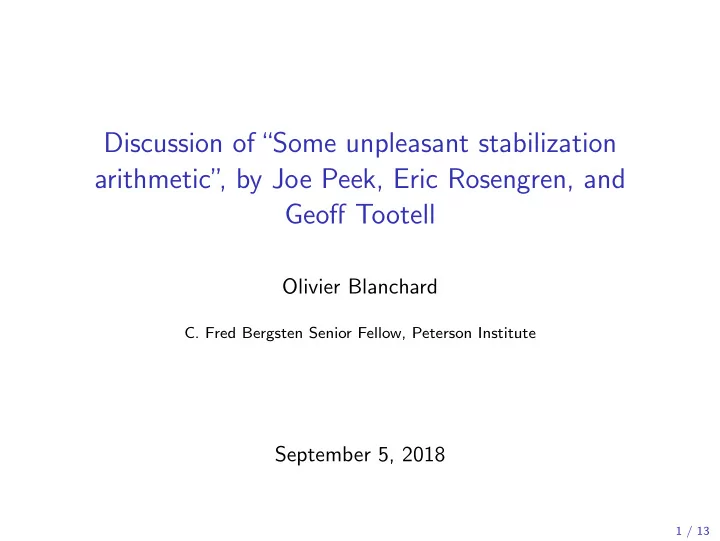

Discussion of“Some unpleasant stabilization arithmetic” , by Joe Peek, Eric Rosengren, and Geoff Tootell Olivier Blanchard C. Fred Bergsten Senior Fellow, Peterson Institute September 5, 2018 1 / 13
Introduction Really two papers ◮ Cyclical differences across states ◮ Differences in economic structure and cyclical sensitivities ◮ Differences in the effects of Federal level (monetary, fiscal, fi- nancial) policies ◮ Differences in state (fiscal) policy responses ◮ The need for additional policy buffers. Are we ready for the next recession? First one extremely interesting, but not central to this conference. Second one a bit underdeveloped. Will focus on that. (A bit unfair to the authors) 2 / 13
Introduction Are we ready for the next recession? Three questions. ◮ How bad will/might the next recession be? ◮ Do we need larger buffers? ◮ If so, do we have them? (Topic of the paper) ◮ Look at monetary, fiscal, financial buffers Look at monetary, fiscal, financial buffers 3 / 13
How bad might the next recession be? How bad might it be? ◮ Run of the mill recession: Average 6% FF rate decline in the absence of ZLB. ◮ Would have been substantially larger in Great Recession, absent ZLB. (Wu-Xia shadow rate, still likely an underestimate: 8.5 ◮ What makes (demand driven) bad recessions bad: Large mul- tipliers. ◮ Great Recession. Large multipliers from liquidity runs. ( the run on repo. Gorton. New Bernanke paper) ◮ Can be better handled. Provide liquidity where needed (despite additional restrictions on the Fed to do so). Type II errors (assuming liquidity when it is solvency) much less costly than Type I. 4 / 13
Monetary buffers Monetary buffers. Need for buffers? 1 ◮ Are ammunitions exhausted? Low rates, and the limits of QE purchases of bonds. ◮ Size of existing balance sheet. Not a constraint. ◮ Skeptical of various schemes to manipulate expectations (price level targeting, conditional PLT, nominal income targeting) ◮ QE purchases of assets with larger premia. Stock portfolios? Crazy? 5 / 13
Monetary buffers Monetary buffers. Need for buffers? 2 ◮ Monetary financing of deficit? Purchases of goods (through Treasury) rather than purchases of assets? Why not? ◮ Goods versus assets. Good commitment device to commit to higher inflation. ◮ Trade-off: Zero interest liabilities of Fed: 2.1 tr (out of 4.3tr). A 1% of GDP increase in public spending, if money financed, implies a 10% increase in relevant money stock, thus eventually a 10% increase in inflation. ◮ Assume it takes five years for the price adjustment to take place (?). Get 1% increase in spending, and 2% lower real rates for 5 years. 6 / 13
Monetary buffers Monetary buffers. Increasing buffers? ◮ Measures above may be seen as extreme (they are... Relevant for a really bad recession) ◮ Undo QE, reduce size of balance sheet faster? But need to ac- company with lower short rates. (Increase one buffer, decrease another) So not obviously better ◮ The best, cheapest, buffer: Higher nominal rates, thus higher inflation. [Sorry to push, but it seems so natural/attractive...] ◮ To get there: Run the economy above potential with low inter- est rates for as long as needed. (Might allow for building fiscal buffers. More below) 7 / 13
Monetary buffers Fiscal buffers. Need for buffers? 1 ◮ Is fiscal space really so limited? Debt versus debt service. ◮ r < g . 10-year rate: 3%. Target inflation 2%. P(growth less than 1% over the next 10 years)? ◮ Evidence from inflation-indexed bonds. Yields on 10-year, 30- year below 1%. (can be locked in) ◮ Historically r < g . Post 1950: -1.45% using 1-year bonds, and -0.63% using 10-year bonds ◮ If so, no tax burden from higher debt. ◮ What if, starting from debt/gdp ratio in year xx, zero primary balance from then on? Figure. 8 / 13
Monetary buffers Fiscal buffers. Need for buffers? 1 Debt path implied by r and g without p. deficit conditional on starting point, with tax adjustment 100 80 % of GDP 60 40 20 1950 1960 1970 1980 1990 2000 2010 2020 year Source: Shiller, BEA, CBO, Treasury, FRED 9 / 13
Monetary buffers State fiscal buffers. Increasing buffers? 1 Correlations of cross-state distributions of the increase in the state unemployment rate (from the start of the recession to the maximum unemployment rate) across the last five recessions Jan 1980 July 1981 July 1990 March 2001 Dec 2007 Jan 1980 - 0.51 -0.14 0.28 0.34 July 1981 0.51 - -0.01 0.20 0.34 July 1990 -0.14 -0.01 - 0.20 0.37 March 2001 0.28 0.20 0.20 - 0.27 Dec 2007 0.34 0.34 0.37 0.27 - 10 / 13
Monetary buffers State fiscal buffers. Increasing buffers? 2 ◮ In principle, federal government (through income tax and unem- ployment insurance) support could do it. Automatically more for states with lower income growth or higher unemployment. ◮ Evidence: Distinguish between redistribution (from rich to poor state) and insurance (cyclical deviations). Estimates for insur- ance: offset around 10%. (Von Hagen survey, 2001) ◮ In nearly all states, tight constraints on borrowing. Small rainy day funds. ◮ Should those constraints be relaxed? 11 / 13
Monetary buffers Financial buffers. ◮ Capital ratios appear sufficient. re: stress tests (the issue of smaller banks) ◮ But substantial uncertainty/disagreement about the macro cost of higher ratios, both dynamics and steady state ◮ In this light, maybe a good time to explore implications of higher ratios ◮ If it turns out to slow demand, offset through lower policy rates 12 / 13
Monetary buffers Tentative conclusions ◮ Enough existing buffers to fight a run-of-the-mill recession ◮ In particular: Existing fiscal buffers may be sufficient. ◮ To build bigger ones in anticipation, typically trade-offs: ◮ Fiscal austerity, but lower policy rates. Higher capital ratios, but lower policy rates. (Higher inflation, but ? ) ◮ If another“Great recession” , plenty of out-of-the-box tools, dan- gerous but likely effective. 13 / 13
Recommend
More recommend